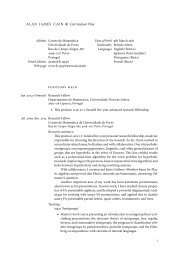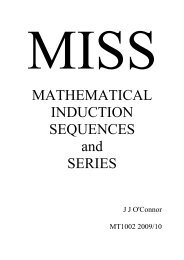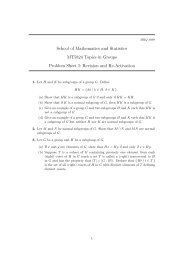Malcev presentations for subsemigroups of direct products of ...
Malcev presentations for subsemigroups of direct products of ...
Malcev presentations for subsemigroups of direct products of ...
You also want an ePaper? Increase the reach of your titles
YUMPU automatically turns print PDFs into web optimized ePapers that Google loves.
There<strong>for</strong>e δ > (γ − 1)/2. Assume that 2δ = γ − 1 + ϵ, where ϵ > 0. Then thefirst component <strong>of</strong> u β+2 begins with p, <strong>for</strong>cing u β+2 = c. Thenu = (x 2 (pqrs) α+γ+1 pqr · · · , xp (α+γ)/2 q · · · ),v = (x 2 (pqrs) α+γ+ϵ p · · · , xp α qr δ · · · ).Suppose ϵ = 1. Since v α+δ+3 begins with q and v α+δ+3 ≠ i, it must holdthat v α+δ+3 = j, which <strong>for</strong>ces u β+3 = e. Considering second componentsthen requires δ = 0, which is impossible. So ϵ ⩾ 2 and the first component <strong>of</strong>u β+3 · · · u ξ must begin (spqr) ϵ−2 sp. So the letter u β+3 must begin a string <strong>of</strong>ϵ − 1 letters d. That is, u β+3 , …, u β+ϵ+1 must all be d. This givesu = (x 2 (pqrs) α+γ+ϵ pqr · · · , xp (α+γ)/2 qr ϵ−1 · · · ),v = (x 2 (pqrs) α+γ+ϵ p · · · , xp α qr δ · · · ).The first component <strong>of</strong> v α+δ+3 must begin qr, which <strong>for</strong>ces v α+δ+3 = j. Thefirst component <strong>of</strong> u β+ϵ+2 must begin sy 2 , which <strong>for</strong>ces u β+ϵ+2 = e. Sou = (x 2 (pqrs) α+γ+ϵ+1 y 2 · · · , xp (α+γ)/2 qr ϵ−1 s · · · ),v = (x 2 (pqrs) α+γ+ϵ+1 y 2 · · · , xp α qr δ s · · · ).Examine the second components <strong>of</strong> u and v to get (α+γ)/2 = α and ϵ−1 = δ.Since 2δ = γ − 1 + ϵ, it follows that α = γ = δ. Sov = v 1 (v 2 · · · v α+1 )v α+2 (v α+3 · · · v α+δ+2 )v α+δ+3 · · ·= fg α hi α j · · · ,which contradicts v’s membership <strong>of</strong> the set <strong>of</strong> normal <strong>for</strong>ms N. 4The semigroup S is there<strong>for</strong>e isomorphic to that <strong>of</strong> [CRRa, § ], which doesnot admit a finite <strong>Malcev</strong> presentation. To see this, observe that the universalgroup <strong>of</strong> S iswhereG = Gp⟨A | R⟩ ≃ FG(a, b, c, d, e) ∗ K FG(f, g, h, i, j) ,K = Gp⟨ab α cd α e : α ∈ N ∪ {0}⟩ ≃ Gp⟨fg α hi α j : α ∈ N ∪ {0}⟩ .The generating set {ab α cd α e : α ∈ N ∪ {0}} <strong>for</strong>ms a basis <strong>for</strong> the amalgamatedsubgroup K by [LS, Proposition I..]. So K is not finitely generated, and soa theorem <strong>of</strong> Baumslag [Bau] shows that the free product G is not finitelypresented. Thus, as its universal group is not finitely presented, S cannot admita finite <strong>Malcev</strong> presentation. . The <strong>direct</strong> product <strong>of</strong> two free semigroups <strong>of</strong> rank at least 2 is not <strong>Malcev</strong>coherent.Pro<strong>of</strong> <strong>of</strong> 5. Let D be the <strong>direct</strong> product <strong>of</strong> two free semigroups <strong>of</strong> rank at least2. The free semigroup <strong>of</strong> rank 2 contains isomorphic copies <strong>of</strong> free semigroups<strong>of</strong> every rank; D there<strong>for</strong>e contains a subsemigroup isomorphic to the <strong>direct</strong>product {x, y, p, q, r, s} + × {x, y, p, q, r, s} + . The semigroup D thus contains thefinitely generated subsemigroup S <strong>of</strong> Example , which does not admit a finite<strong>Malcev</strong> presentation. There<strong>for</strong>e D is not <strong>Malcev</strong> coherent. 5














